"His daring note choices and diverse skills are what make him a master fingerpicker and flatpicker." Learn Travis picking, harp harmonics and 8 other techniques that make Tommy Emmanuel an acoustic tour de force
Put key elements of the acoustic shredder's style to work in your own playing with these video tutorials
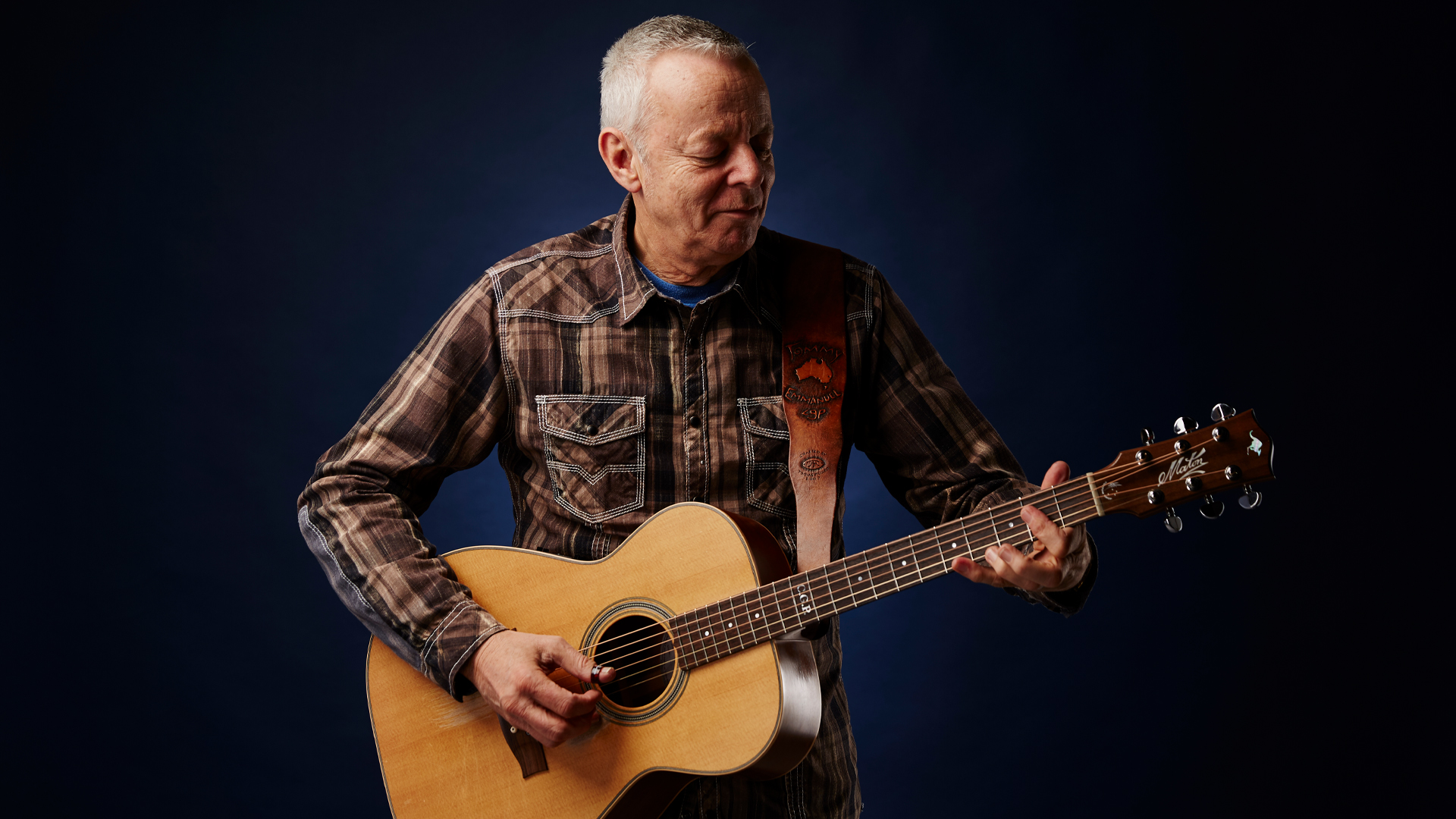
In his book Outliers: The Story of Success, author Malcolm Gladwell asserts that at least 10,000 hours of practice are required to excel at any given skill. If that’s indeed the case, Australian acoustic guitar maestro Tommy Emmanuel certainly has a lot more than that under his belt. One of only five guitarists to be bestowed the title “Certified Guitar Player” by the legendary Chet Atkins — a “C.G.P.” inlay marks the 12th fret of his signature TE series Maton guitars — Emmanuel is a master of precision, control, touch and tone, with a signature style honed by decades of writing and interpreting a vast array of songs, while relentlessly refining his technique.
It would be a daunting task to try to cover the totality of Emmanuel’s style in one lesson, as he is both a master fingerpicker and flatpicker. So, here, we’ll be exploring just some of the guitarist’s favorite fingerstyle approaches and techniques. Lucky for us, one of New York City’s finest fingerstylists, Gilber Gilmore (Instagram: @gilber_gilmore, YouTube: 1972f1972,), has graciously joined us once again to create videos to accompany all of this lesson’s examples, which you’ll find at guitarplayer.com.
As you’ll see in these musical examples, fingerstyle guitar music is often notated with opposite stemming, also known as divisi notation, which allows two independent melodic or harmonic “voices” to be clearly shown and visualized for the reader. Up-stemmed notes are generally picked with the fingers, and down-stemmed notes are most often picked with the thumb. In addition, much the same way that fret-hand fingers are indicated with numbers, pick-hand fingers are traditionally assigned a letter, based on the Spanish words for the various digits: p (thumb), i (index), m (middle) and a (ring).
Note that Emmanuel most often uses a thumbpick, but it’s optional here, as is his use of the fret-hand thumb to play certain notes on the 6th string, indicated in the examples by the abbreviation “Th.” Okay, now we’re ready to discover just what makes this guitar genius tick.
One of the foundational techniques of Emmanuel’s style is Travis picking, named for Merle Travis, the iconic country and western singer, songwriter and guitarist. Its hallmark feature is the use of alternating bass notes on different strings, picked with the thumb, with a fairly consistent palm mute applied to the low E, A and D strings to prevent the bass notes from ringing, or “bleeding,” into each other and keep the bass notes sounding tight and punchy while notes on the higher strings are allowed to ring. When Travis picking, you’ll find that lightly palm muting the bass strings will additionally help you feel them more easily and better control your fingerpicking accuracy.
Ex. 1 is inspired by Travis’ classic “Cannonball Rag,” which appears as part of a medley on Emmanuel’s 2006 release The Mystery. To get a feel for Travis picking, start by playing only the thumbpicked notes while holding each of the full chord forms. Once you feel comfortable doing this, add the up-stemmed notes (picked with the fingers). Keep in mind that one of the “secrets” to TE’s success has been repetition, taking the time to work out complex movements slowly, and with a metronome, before bringing them up to tempo. How slow? A good rule of thumb is to start playing something as slow as it takes to work your way through, while playing with good time and no mistakes, at least twice. This gives your brain time to absorb all the nuanced movements involving both hands.
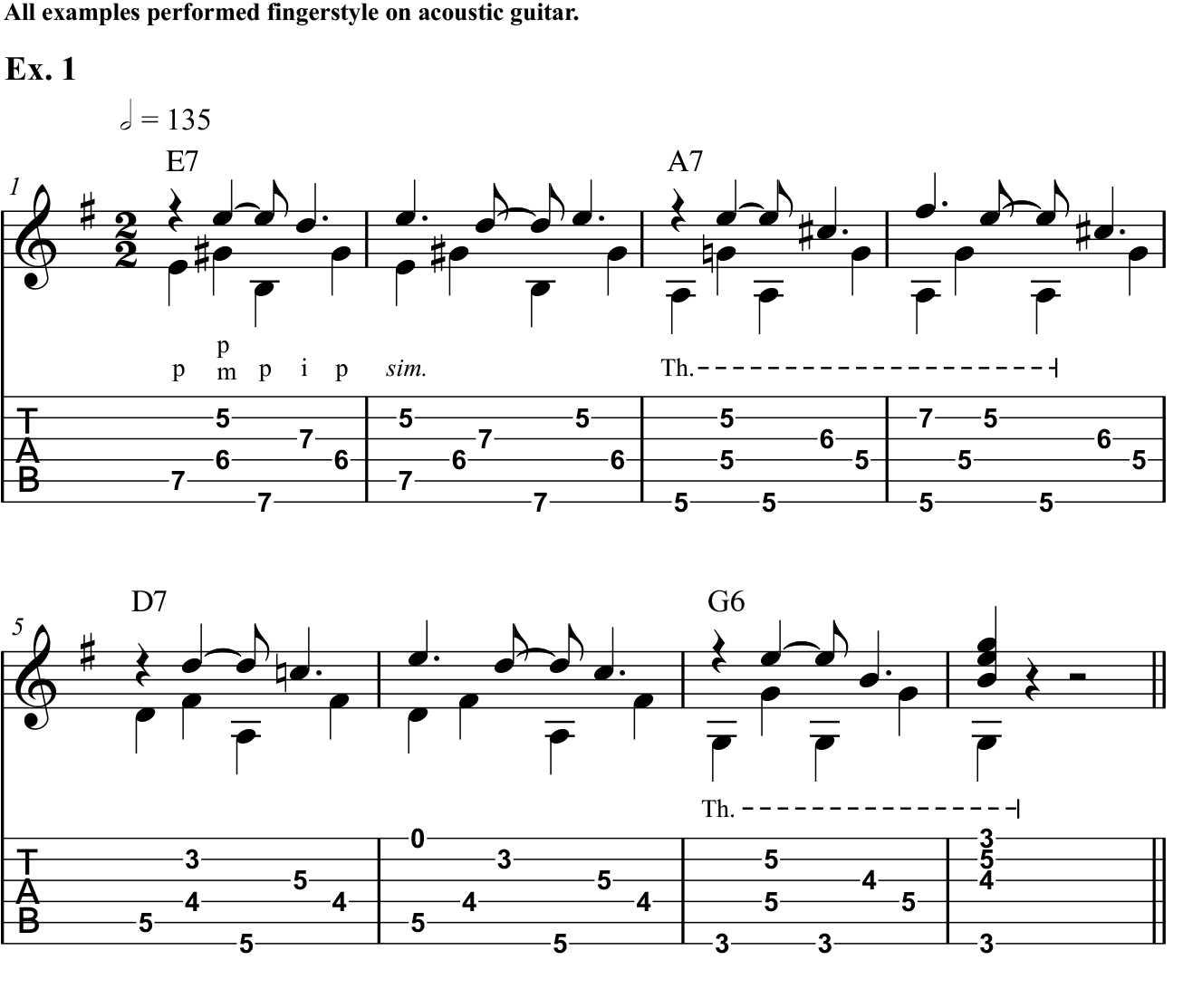
Ex. 2 demonstrates a nifty use of Travis picking to scamper up and down the neck. Notice there’s an open G note between each chord form, allowing for more seamless position shifts, while adding a bit of a country “chicken pickin’” sound. The focus here is mainly on your pick-hand thumb, as your middle finger handles most of the remaining notes, which are generally found on the 3rd string. There are two spots, however, beat 3 of bar 6 and the very last chord, where TE would likely strum with his thumbpick, so as to accentuate these beats. (Notice the accent marks, indicating to play these beats a bit louder for emphasis.) No problem if you don’t have a thumbpick; strumming with the backs of your fingernails will produce a similar bite.
All the latest guitar news, interviews, lessons, reviews, deals and more, direct to your inbox!
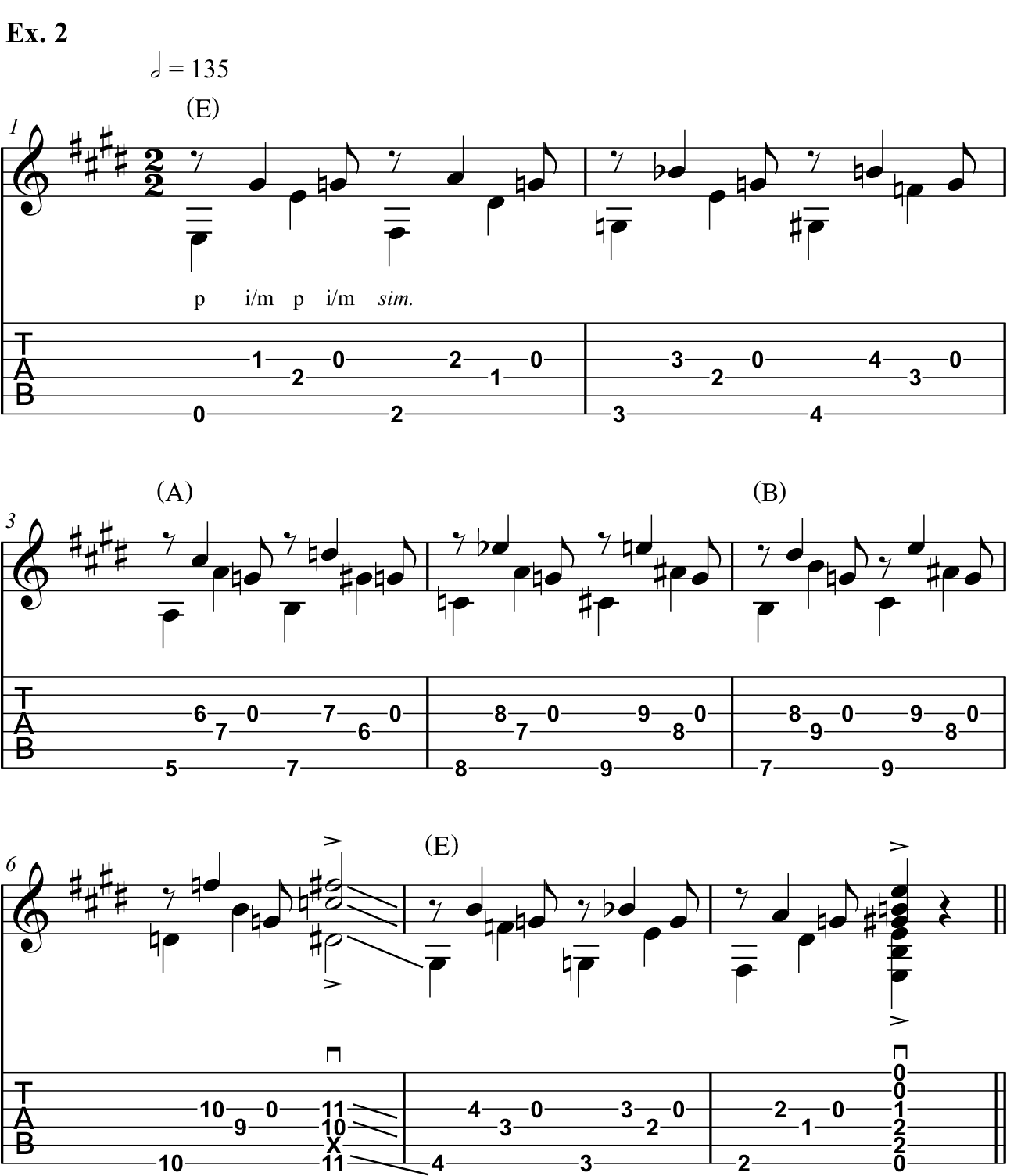
Ex. 3 is reminiscent of “Son of a Gun,” from 2004’s Endless Road. Written for Travis’s son, Thomas Bresch, it has Emmanuel in full freight train mode. You won’t find much new material technique-wise, but it does require working the different phrases up to a breakneck speed. To do this, repeat each two-bar phrase multiple times until you get the hang of it; then work on connecting them. Breaking music down into more digestible chunks is another effective way to learn parts more quickly.
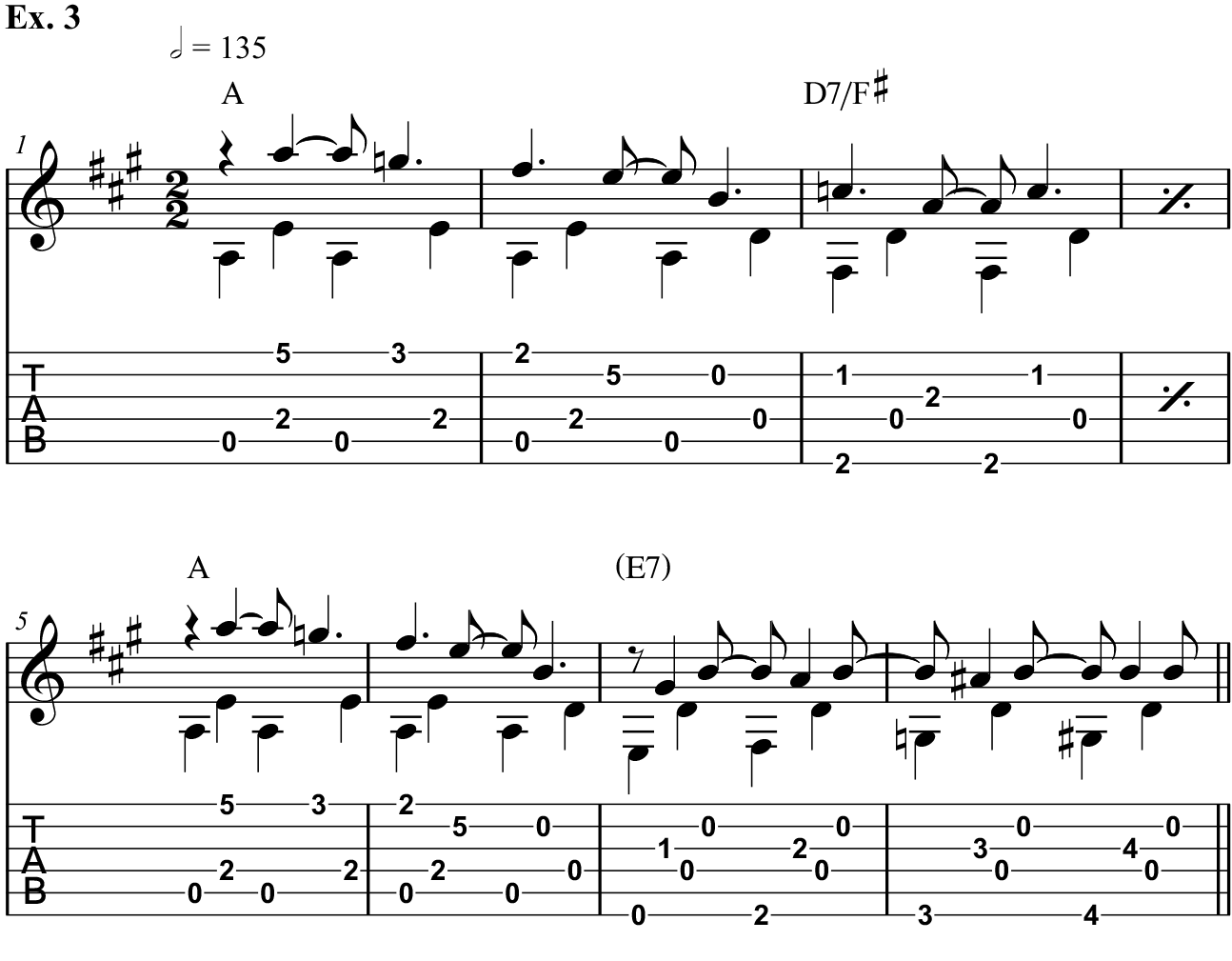
Next up, Ex. 4 is along the lines of classical guitarist and composer Mason Williams’ “Classical Gas,” which Emmanuel often performs. While it has some elements of Travis picking, there’s a different interplay between the melody and accompaniment. Welcome to the art of arranging — creating a unique rendition of a song by melding the melody and accompaniment in a compelling way. This is at the heart of what Tommy has dedicated himself to, as he has forged his signature style by combining his adventurous musical instincts with a vast arsenal of blistering techniques. Notice how, in bars 2 and 4, the whole-note melody leaves space for the accompaniment to take over, allowing for descending bass lines to mingle with higher, droning notes. In similar fashion, Bar 5 introduces hammer/pull double-stops, giving our ears something new and unexpected.
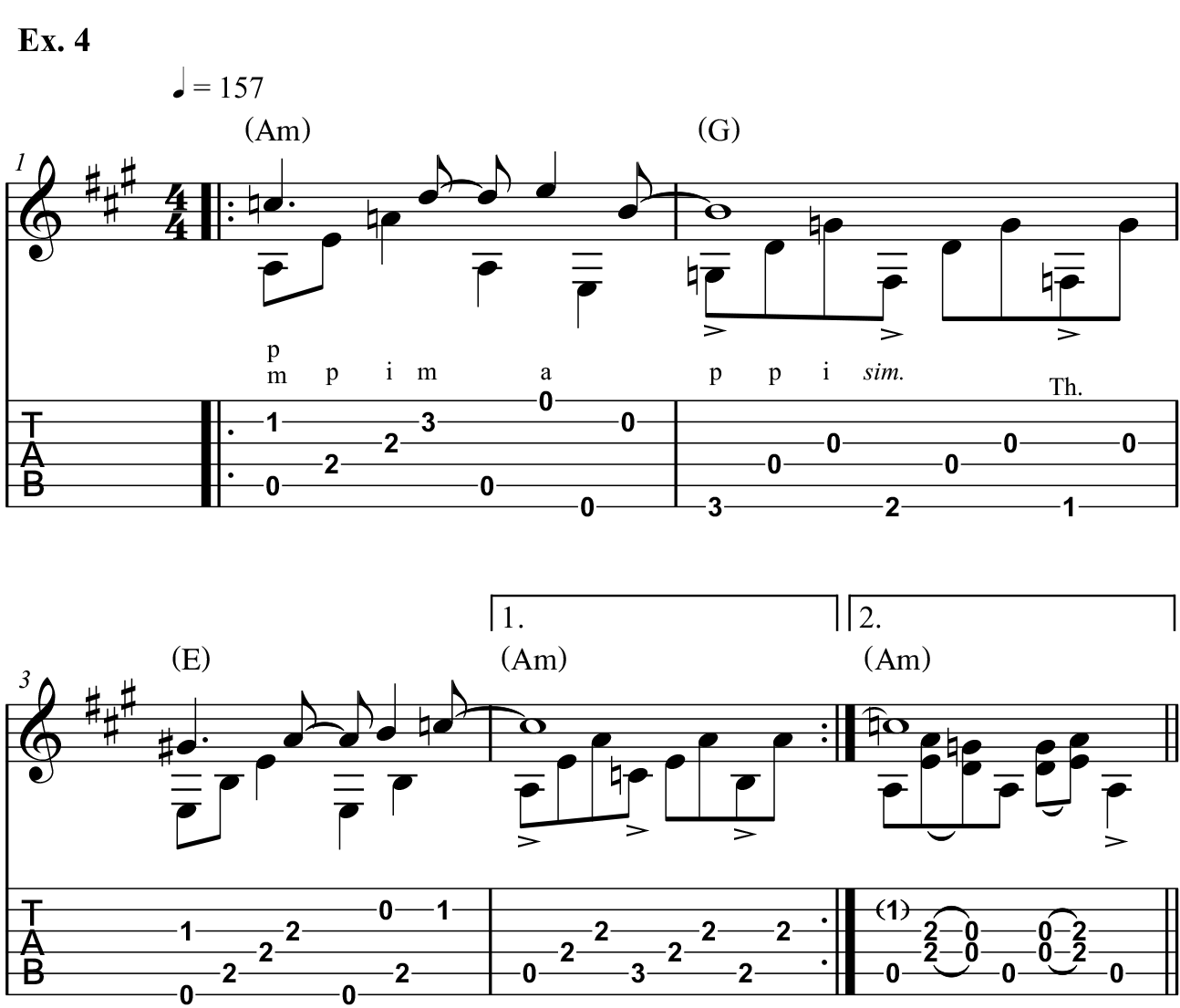
Emmanuel introduces all kinds of ingenious techniques into his arrangements to pique the listener’s interest. One example is his use of banjo rolls, via fingerpicking patterns more commonly associated with banjo players. Ex. 5 is a great example; after getting it under your fingers, try playing it as an intro to Ex. 3 to get a sense of how TE uses different techniques to create musical drama in his arrangements and propel a song forward.
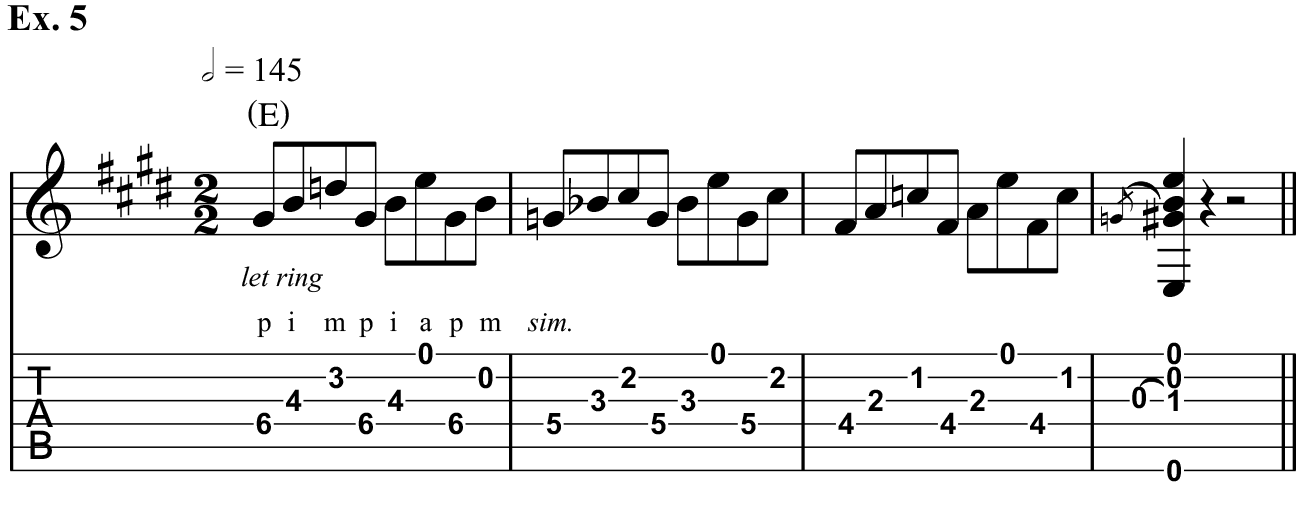
Another way the guitarist keeps things interesting is by employing lightning-quick single-note licks. Ex. 6 uses clever open-string pull-offs to again tap into chicken pickin’s bouncy quality. It’s one of those licks that sounds intimidating, but in actuality is easier to play than it sounds. As indicated, you’ll need only your pick-hand thumb and middle finger to create the repeating pattern, and note how the cagey pull-offs create darting, angular lines that really keep things moving.
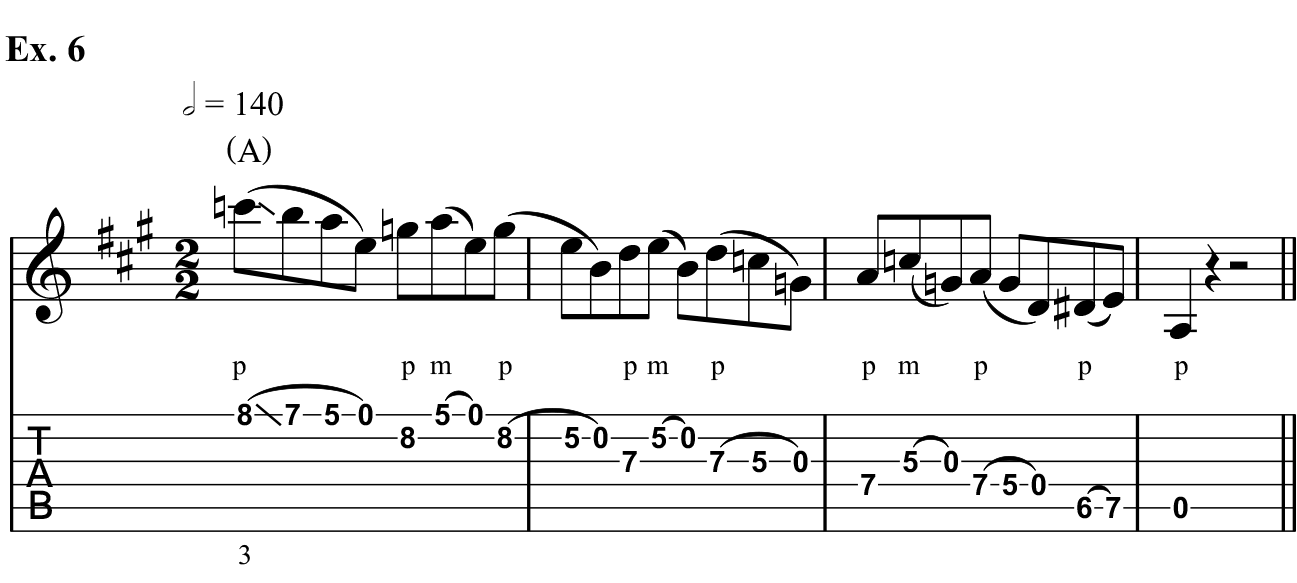
Ex. 7 presents us with a different sort of challenge. Inspired by Tommy Emmanuel’s arrangement of the Beatles’ “Day Tripper,” part of his sensational “Beatles Medley,” from 2005’s Live One, it requires us to keep a steady quarter-note rhythm on top of a melodic bass riff. But before exploring this aspect of the figure, let’s take a moment to notice how the first two bars have virtually no down-stemmed (thumb-picked) notes. This is a clever arranging technique to keep in your bag of tricks, as it creates a tangible anticipation, setting the stage for a dramatic entrance by the bass line. Listening to some of Emmanuel’s arrangements, it quickly becomes apparent that they’re chock-full of these musical signposts, keeping us on our toes. Note the staccato dots appearing above each beat, indicating to play these notes short. This is accomplished here by lightly resting your pick-hand fingers on the strings quickly after sounding the notes. Things really get interesting during the last two beats of bars 3 and 4, when your pick-hand finger independence and overall rhythmic equilibrium are both put to the test, as eighth-note bass lines are played over the static quarter-note pulse.
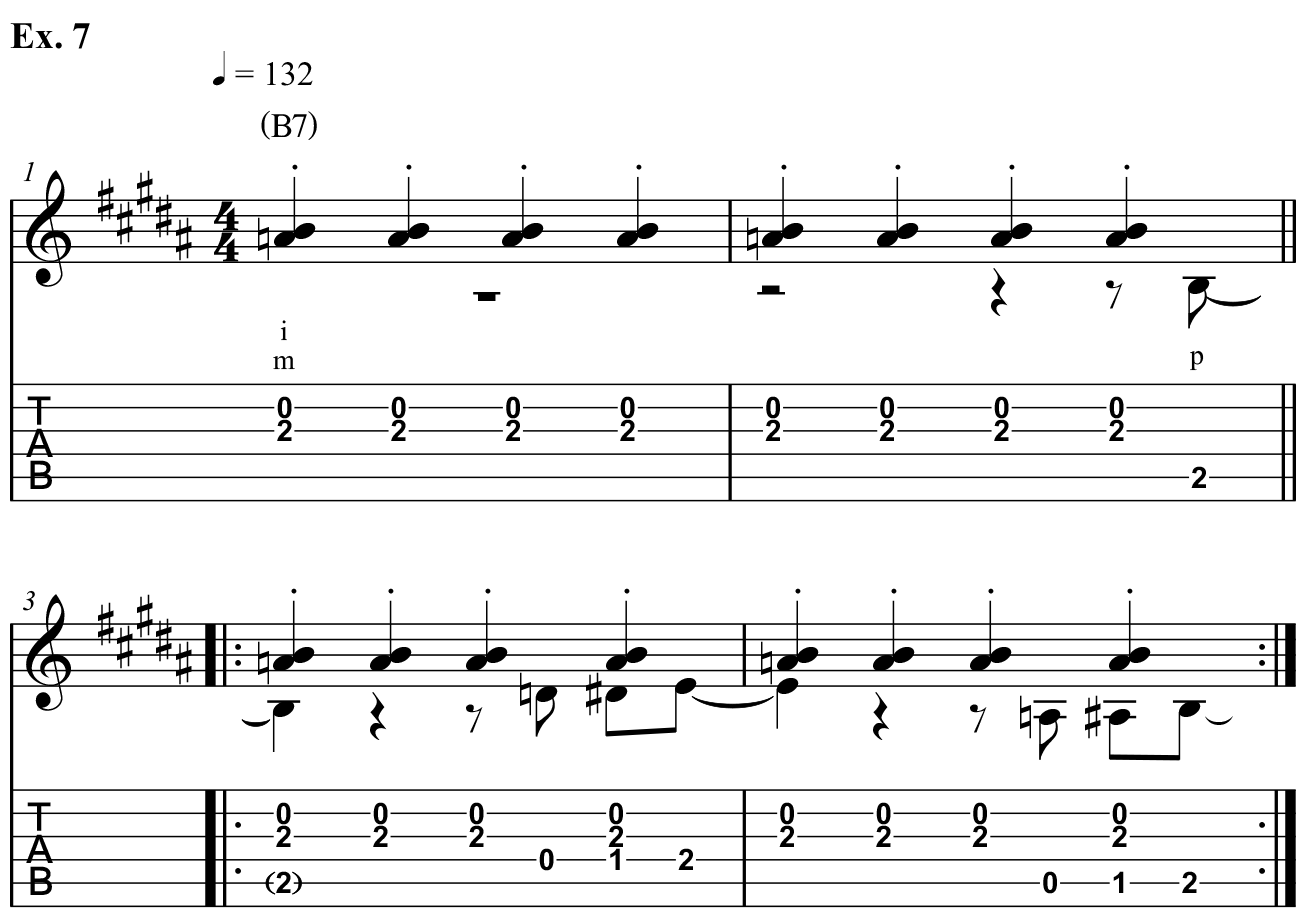
It’s crucial to note that creating a compelling arrangement does not necessarily mean it has to be a complex one. Emmanuel has said that one of his main focal points when arranging is a song’s melody and how best to interpret and convey it on guitar, both from a rhythmic standpoint and in terms of employing the guitar’s articulation nuances, such as bends, finger slides and vibrato. A great way to do this is to actually sing the melody, then try to capture what you’ve sung. Let’s look at the basic melody to the traditional song “Amazing Grace” and see if we can find a creative way to play it so that it sounds more natural and soulful on guitar. Ex. 8a is a bare-bones rendition of a snippet of the tune’s melody, as you might find it in a beginner’s fingerstyle method book.
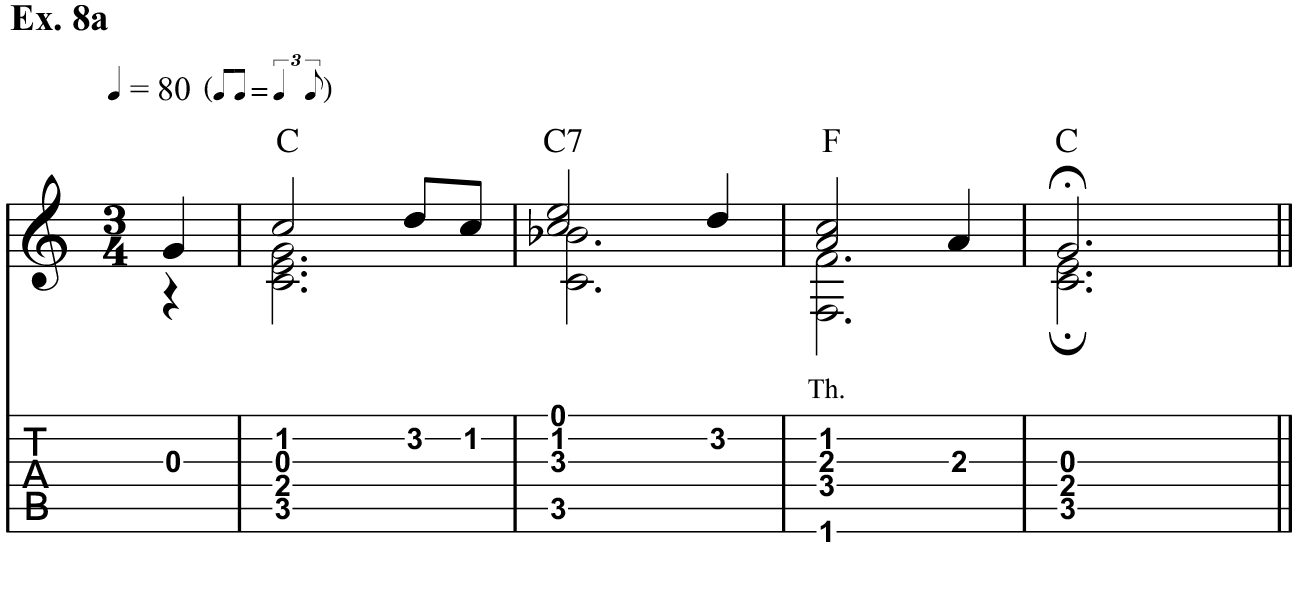
Ex. 8b brings the same melody new life by using some basic arranging techniques. Looking at the melody, now incorporated are a pull-off, finger slide and hammer-on, which ornament the articulations and phrasing over the first three bars, with grace-note finger slides added to beat 4 of bar 3. Note also how we’ve changed the rhythm on that beat, so that the G note now anticipates the final bar. In the accompaniment, notice how the chords are quickly arpeggiated on beat 1 of bars 1 and 3, and how some rhythmic motion has been added in bar 2. Finally, a gentle hammer-on rounds out the phrase in bar 4. Now you’re playing music, instead of just notes.
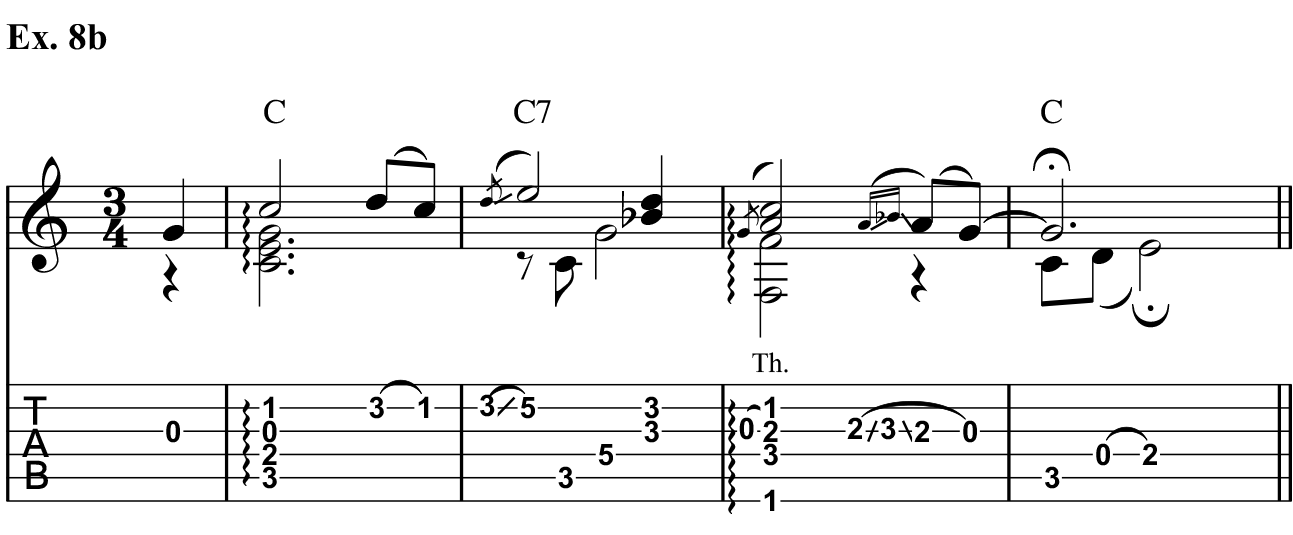
Let’s finish things off with one of TE’s most favorite techniques, the harp harmonic (“H.H.”). Invented by Chet Atkins and developed even further by Lenny Breau, a harp harmonic is sounded by fingerpicking a fretted note while touching the string very lightly with the tip of your pick hand’s index finger at a node, typically 12 frets higher, to generate an octave-higher harmonic. While doing this, pluck the string with your thumbnail (or thumb-pick). The result should be a harmonic one octave above the fretted pitch, comparable to a 12th-fret natural harmonic on an open string. Note that, just as other, higher natural harmonics can be sounded on an open string — for example, seven or five frets above the nut or “zero fret” — the same is true with harp harmonics.
Ex. 9 employs these harmonics to an open D chord, adding some extra sparkle. Next to the initial tab number indicating the fretted note or open string, you’ll find another number in parentheses, which indicates the fret above which you are to lightly touch the string as you pick it. Just as you would with a natural harmonic produced with open strings, be sure to touch the string directly over the fret indicated, in order to correctly target the harmonic node.

Like Breau, Emmanuel often mixes harp harmonics with regular fretted pitches, creating a lush, cascading effect. Ex. 10 is inspired by his version of “Somewhere Over the Rainbow” from Endless Road, which begins with a beautiful harp harmonics-fueled intro. The key is to let the notes ring over each other by having each chord form fretted before sounding the first note of each bar. Notice how incorporating harmonics into basic chord shapes produces a smooth, scalar line.

If you are to take just one thing away from having spent this time with Emmanuel’s music, remember that it’s how he plays the notes, by way of his daring arranging choices and masterful use of charismatic techniques, that contributes so much to his being a most exceptional player — a Certified Guitar Player, that is.
Jeff Jacobson is a guitarist, songwriter and veteran music transcriber, with hundreds of published credits. For information on virtual guitar and songwriting lessons or custom transcriptions, reach out to Jeff on Twitter @jeffjacobsonmusic or visit jeffjacobson.net.












